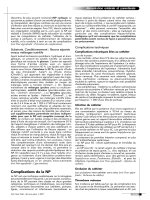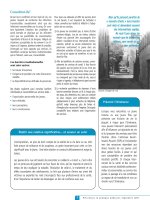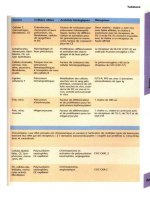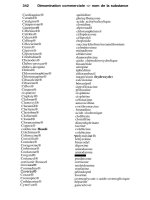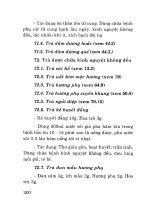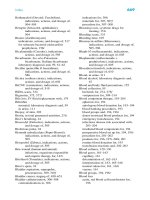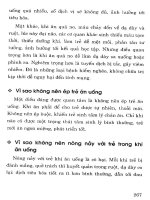Safer Surgery part 10 ppt
Bạn đang xem bản rút gọn của tài liệu. Xem và tải ngay bản đầy đủ của tài liệu tại đây (1.06 MB, 10 trang )
Safer Surgery
64
OSATS over the last two years prior to the formal requirement of OSATS within
the new training and education programme. In other disciplines, there has been
some cynicism towards competency based surgical assessment which has required
our concerted efforts to overcome in implementing the study. However this does
appear to be changing over time and with the opportunities provided by the study
for training assessors and trainees.
The method we used to fully understand the systems and processes adopted
by each specialty has been to spend several weeks working with the specialty in
advance of assessments. This has enabled us to maximize recruitment of cases,
not only through an appreciation of the practical listing of surgical cases, but by
engaging with the working practices and culture of each surgical team.
Lessons Learnt and Suggested Learning Points
Consider the specic nature of context for implementing studies in the
surgical workplace.
Spend time working with surgical teams to maximize the success of the
research.
Future Research Directions
The use of video recordings has potential in providing trainees with additional
feedback on their surgical performance. Feedback using videos is well established
within general practice. Videotaped patient consultations are used for training
(Pendleton et al. 1984) and assessment purposes, with videotaped consultations
forming part of the current summative assessment for GP training, the new
Membership of the Royal College of General Practitioners (Royal College of
General Practitioners 2008). They have been shown to be valid and reliable as an
assessment method for trainees (Campbell et al. 1995), and for practising general
practitioners (Ram 1999).
We aim to develop the use of videoed operative cases for providing surgical
trainees with feedback. There is reliability evidence for video assessment of
some surgical procedures. Beard et al. (2005a) showed good inter-rater reliability
between direct and video assessment of saphenofemoral ligation. There is also
evidence that giving trainees feedback on their surgical performance improves
their surgical skill (Grantcharov et al. 2007). Our study is investigating the
delity and reliability of video recordings in different specialties. If we can show
sufcient reliability of video recordings for these index procedures, we will be
able to formally evaluate videos as a tool for providing feedback and additional
training. Our premise is that video feedback, as an adjunct to verbal feedback from
a trainer, will provide a feasible improvement to surgical training.
•
•
Surgical Skills and Non-Technical Behaviours in the Operating Room
65
Summary
The intention of this chapter has been to provide a study overview to demonstrate
the alignment of the study design and methodology to the study aim and main
research questions. We have illustrated the implementation of the study using a
descriptive analysis of our problem-solving approach. It is hoped that valuable
lessons from our team experience can be drawn upon by researchers in the eld,
or trainers with a responsibility for workplace assessment.
Acknowledgements
The research team was the successful applicant for a grant provided by the NHS
Research and Development Programme for research into the assessment of surgical
skills in the UK.
References
Beard, J.D., Jolly, B.C., Newble, D.I., Thomas, W.E.G., Donnelly, J. and Southgate,
L.J. (2005a) Assessing the technical skills of surgical trainees. British Journal
of Surgery 92, 778–82.
Beard, J.D., Jolly, B.C., Southgate, L.J., Newble, D.I., Thomas, E.G. and Rochester,
J. (2005b) Developing assessments of surgical skills for the GMC Performance
Procedures. Annals of the Royal College of Surgeons 87, 242–7.
Calman, K.C., Temple, J.G., Naysmith, R., Cairncross, R.G. and Bennett, S.J.
(1999) Reforming higher specialist training in the United Kingdom – a step
along the continuum of medical education. Medical Education 33, 28–33.
Campbell, L.M., Howie, J.G. and Murray, T.S. (1995) Use of videotaped
consultations in summative assessment of trainees in general practice. British
Journal of General Practice 45, 137–41.
Crossley, J., Davies, H., Humphris, G. and Jolly, B. (2002) Generalisability: A key
to unlock professional assessment. Medical Education 36, 972–8.
Department of Health (1993) Hospital Doctors: Training for the Future. The report
of the Working Group on Specialist Medical Training (the Calman Report).
London: Department of Health.
Department of Health (2003) HSC 2003/001 – Protecting Staff; Delivering
Services: Implementing the European Working Time Directive for Doctors in
Training. Available at: < />lettersandcirculars/healthservicecirculars/DH_4003588> [accessed March
2009].
Downing, S.M. (2003) Validity: On the meaningful interpretation of assessment
data. Medical Education 37, 830–7.
Safer Surgery
66
Downing, S.M. (2004) Reliability: On the reproducibility of assessment data.
Medical Education 38, 1006–12.
Galasko, C. and Mackay C. (1997) Unsupervised surgical training: Logbooks are
essential for assessing progress. British Medical Journal 315, 1306–1307.
General Medical Council (1998) Good Medical Practice. London: General
Medical Council.
Gold, R.L. (1958) Roles in sociological eld observations. Social Forces 36, 217–
23.
Grantcharov, T.P., Schulze, S., Kristiansen, V.B. (2007) The impact of objective
assessment and constructive feedback on improvement of laparoscopic
performance in the operating room. Surgical Endoscopy 21, 2240–3.
Katory, M., Singh, S. and Beard, J.D. (2001) Twenty Trent trainees: A comparison
of operative competence after BST. Annals of the Royal College of Surgeons
83, 328–30.
Martin, J.A., Regehr, G. Reznick, R., Macrae, H., Murnaghan, J., Hutchison,
C. and Brown, M. (1997) Objective structured assessment of technical skill
(OSATS) for surgical residents. British Journal of Surgery 84(2), 273–8.
Pendleton, D., Schoeld, T., Tate, P. and Havelock, P. (1984) The Consultation: An
Approach to Learning and Teaching. Oxford: Oxford University Press.
PMETB (2008) Standards for Curricula and Assessment Systems. Available at:
< />Scas_July2008_Final.pdf> [accessed March 2009].
Ram, P. Grol, R., Rethans, J.J., Schouten, B., van der Vleuten, C. and Kester,
A. (1999) Assessment of general practitioners by video observation of
communication and medical performance in daily practice: Issues of validity,
reliability and feasibility. Medical Education 33, 447–54.
Royal College of General Practitioners (2008) Curriculum and Assessment Site.
Available at />Schuwirth, L.W.T., Southgate, L., Page, G.G., Paget, N.S., Lescop, J.M.J., Lew,
S.R., Wade, W.B. and Baron-Maldonado, M. (2002) When enough is enough:
A conceptual basis for fair and defensible practice performance assessment.
Medical Education 36, 925–30.
Thornton, M., Donlon, M. and Beard, J.D. (2003) The operative skills of higher
surgical trainees: Measuring competence rather than experience undertaken.
Annals of the Royal College of Surgeons 85, 190–3.
Van der Vleuten, C.P.M. (1996) The Assessment of Professional Competence.
Advances in Health Sciences Education 1, 41–67.
Winckel, C.P., Reznick, R.K., Cohen, R and Taylor, B. (1994) Reliability and
construct validity of a structured technical skills assessment form. American
Journal of Surgery 167(4), 423–7.
Yule, S., Flin, R., Maran, N., Rowley, D., Youngson, G.G. and Paterson-Brown,
S. (2008) Surgeons’ non-technical skills in the operating room. Reliability
testing of the NOTSS behaviour rating system. World Journal of Surgery 32,
548–56.
Chapter 5
Scrub Practitioners’ List of Intra-Operative
Non-Technical Skills – SPLINTS
Lucy Mitchell and Rhona Flin
Modern surgery requires a group of people with a variety of skills to work together
effectively to deliver patient care. In addition to their technical expertise, members
of an operating theatre (OT) team will utilize a range of ‘non-technical’ skills. These
are the cognitive and social skills that complement technical skills to achieve safe and
efcient practice. Taxonomies of these non-technical skills have already been identied
for anaesthetists’ (see Glavin and Patey, Chapter 11 in this volume, Fletcher et al. 2004)
and surgeons’ performance (see Yule et al., Chapter 2 in this volume, Yule et al. 2006b)
in the intra-operative phase of surgical procedures. Another key member of the theatre
team is the scrub (or instrument) nurse, practitioner or technician,
1
who works directly
with one or more surgeons while they are operating on the patient. As there was no
taxonomy of non-technical skills for this member of the scrub team, a research project
(funded 2007–2009 by NHS Education Scotland) was established to identify these
skills and this chapter will describe the ndings of the SPLINTS project to date.
Background
The aviation industry lead the way in the non-technical skills approach by developing
special research programmes to identify pilots’ cognitive and interpersonal skills
that inuenced ght safety. These skills are trained in special courses called Crew
Resource Management (CRM) with the aim of reducing human error and improving
the performance of ight crews (see Musson in Chapter 25, Wiener et al. 1993).
The effectiveness of CRM training can be evaluated by using attitude surveys or
observing and rating individuals’ performance during task execution to establish
whether training has resulted in knowledge transfer and improved skill execution
(O’Connor et al. 2008). To increase the reliability and objectivity of these observations,
behavioural assessment tools have been developed by listing the observable non-
technical skills taught in these courses and devising a rating system to assess them.
Other high risk work settings such as nuclear power, shipping and military have also
accepted that human factors impact on safety and production and have also developed
1 Although this project focussed on scrub nurses, the resulting skills taxonomy will be
relevant to the scrub role whether that is performed by a nurse, practitioner or technician.
Safer Surgery
68
this type of training and assessment method (Flin et al. 2008). In recent years, there
have been efforts to extend the research and training in non-technical skills into areas
of acute healthcare services, such as surgery, trauma centres and intensive care units
(ICUs) (Baker et al. 2007). A recommended tool for rating individual airline pilots’
behaviour called NOTECHS was developed by European pilots and psychologists
(see O’Connor et al. 2002) and it has been adapted to rate teamwork in the operating
theatre (see Catchpole et al. in Chapter 7, Undre and Sevdalis in Chapter 6). Rather
than adapt tools designed for airline pilots, some other research teams have taken a
task analysis approach to identify non-technical skills, e.g., in anaesthesia (Fletcher
et al. 2004), surgery (Yule et al. 2006a; 2006b), ICU (Reader et al. 2006) and
neonatal resuscitation (Thomas et al. 2004). These investigators have then devised
behavioural rating systems, to evaluate the identied skills and these are now being
used in professional training and formative assessment (see for example, Yule et al. in
Chapter 2). Some of the team-based tools include behavioural ratings of nurses (e.g.,
Catchpole et al. 2008, Undre et al. 2006a) but, despite nurses being a key member
of the operating theatre team, their particular non-technical skills have not been
formally identied. The rst task of our research project was to search the nursing
and psychology literature for any studies of nurses’ non-technical skills.
Literature Review
We searched electronic databases including BioMed Central, NHS e-library, Web-
of-Science; publications from the Association for Perioperative Practice (AfPP),
Association of peri-Operative Registered Nurses (AORN) and university library
catalogues and bibliographies from related research papers. The skill categories
searched for included communication, teamwork, situation awareness, leadership,
decision-making and additional search terms such as lead, trust, discussion and
relationships were included to keep the search as broad as possible.
The literature search identied very few studies, in fact from an initial total of
424 publications identied, only 13 papers had data pertaining to non-technical
skills of scrub nurses (for full details see Mitchell and Flin 2008). Those papers
only discussed the skills relating to scrub nurses’ communication, teamwork and
situation awareness (see Table 5.1).
There were no behaviours identied from this literature which could be
classied as scrub nurses’ leadership or decision-making although these may
be skills which scrub nurses also require. Leadership might be displayed when
assisting/advising junior team members and decisions could be made in relation to
timing requests. For example, deciding when to ask the circulating nurse to bring
warm saline to the table because if it is brought too soon, it will be cooled by the
time the surgeon requires it and if this request is made too late, the surgeon will
have to wait. The identied studies of scrub nurses’ communication, teamwork
and situation awareness are now briey summarized in order to illustrate the types
of behaviours which have received research attention.
Scrub Practitioners’ List of Intra-Operative Non-Technical Skills
69
Categories of Scrub Nurses’ Non-technical Skills
Communication
Communication is seen as fundamental to all types of nursing but the focus has
mainly been on communicating with the patient as opposed to with colleagues.
Despite the recognition that all members of a team require effective communication
skills to enable the smooth running of the operating theatre (OT) (Taylor and
Campbell 2000), insufcient or ineffective communication between team members
in the OT setting has been recognized as a contributing factor to some adverse
events (Helmreich and Schaefer 1994). This has lead to the development of
Non-technical skill
Paper
Communication
Teamwork
Situation
Awareness
Leadership
Decision-
making
Awad et al. (2005)
X X
Baylis et al. (2006)
X
Edmondson (2003)
X X
Flin et al. (2006)
X X
Nestel and Kidd (2006)
X X
Riley and Manias (2006)
X X X
Saunders (2004)
X
Sevdalis et al. (2007)
X
Sexton et al. (2000)
X X
Silen-Lipponen (2005)
X X
Tanner and Timmons (2000)
X
Timmons and Reynolds (2005)
X
Undre et al. (2006b)
X X
Table 5.1 Non-technical skill categories examined in the 13 included
papers
Safer Surgery
70
checklists to promote team communication between the disciplines in the OT (see
Lingard et al. 2005). Studies of nurses have shown general dissatisfaction with
communication in the OT (Nestel and Kidd 2006). Case-irrelevant communications
for example, questions about a previous patient, telephone calls or bleeps within
the OT, particularly those which are intended for the nurse or anaesthetist were
also found to be distracting to the OT team (Sevdalis et al. 2007).
In the USA, CRM principles were used in an attempt to improve communication
through medical team training which included didactic instruction, interactive
participation, training lms, role-play and team briengs. After this intervention
surgeons and anaesthetists reported that communication had improved although
there was no signicant improvement in nurses’ perception of team communication
(Awad et al. 2005). In another study (Edmondson 2003), the ability of team
members to voice concerns or speak up within the hierarchical structure of the OT
was examined during implementation of new technology in cardiac surgery. Since
use of the new equipment required interdisciplinary communication, difculties
staff reported were more behavioural than technical. Nurses reported that nursing
staff in the team had not been accustomed to speaking up – in the past, they would
not have dared do so – but that surgeons had become more amenable to being
questioned and team members listened more to others despite this being contrary
to the previous power-based communication norms. Studies such as these illustrate
that nurses’ communication is obviously a key component of effective teamwork
in this domain.
Teamwork
The composition of perioperative teams can vary, for example, the number of
personnel, individual levels of experience, competence and familiarity of working
together. We identied teamwork papers that mentioned nurse behaviours
intended to aid teamwork such as memorizing surgeons’ preferences and sharing
information. There was also research on the effect on performance of stable versus
exible theatre teams. Attitudes to teamwork and hierarchy were also common
themes discussed in these nursing articles.
Researchers have examined teamwork in the eld of medicine to try to
develop ways to enhance patient safety and increase team cohesion to reduce
error. Perceptions of teamwork have been found to differ between disciplines.
Nurses largely felt that the theatre team was a single unit, in contrast with
surgeons’ impressions of being a member of a team which comprised several
highly specialized sub-teams (Undre et al. 2006b). Sexton et al. (2000) found
low ratings of teamwork by surgical nurses in the USA and Europe when they
rated interactions with consultant surgeons. In a Scottish study, surgeons rated
their quality of relationships with other consultants and nurses equally, whereas
nurses rated teamwork and communication with other nurses higher than between
themselves and surgeons (Flin et al. 2006). Since Stein’s classic paper (Stein
1967), in which the working relationship between doctor and nurse was described
Scrub Practitioners’ List of Intra-Operative Non-Technical Skills
71
as a ‘game’ which involved nurses learning the art of making suggestions to
doctors without appearing to do so, several researchers have considered how this
relationship has evolved (e.g., Hughes 1988, Mackay 1993, Porter 1991, Stein
et al. 1990, Svensson 1996). They have offered differing views as to why the
relationship has changed, but the general consensus is that the relationship has
become more informal over time. Still, ten years later, scrub nurses perceived their
main responsibility as ‘not upsetting’ the surgeon or ‘keeping the surgeons happy’
(Timmons and Reynolds 2005).
Teams in the OT can either be exible, where personnel are rotated, or stable,
where members become used to working together as a unit. However, even within
stable theatre nurse teams, members may alternate between scrub and circulating
roles if they are multi-skilled. A study in Finland, UK and the USA by Silen-
Lipponen et al. (2005) found stable OT teams helped combine team members’
skills, enabled advance planning and promoted safety. When interviewed, less
experienced nurses admitted that in a strange team they felt unable to prepare or
participate in the planning of the surgery. There was also frustration from nurses
towards the attitude of some surgeons, who seemed unaware that their operating
style differed from that of their colleagues when they assumed that nurses would
automatically know what equipment they required, resulting in the nurses becoming
ustered and liable to make errors, causing concern for patient safety. Baylis et al.
(2006) concluded that staff on unplanned leave being replaced in the team by
temporary staff resulted in a higher incidence of complications. Familiarity with
a surgeon’s way of working helps the scrub nurse to anticipate what the surgeon
will need and in what order. This cognitive skill, called ‘situation awareness’, was
considered from the scrub nurses’ perspective in only one paper.
Situation Awareness
Situation awareness is dened as ‘the perception of the elements in the environment
within a volume of time and space, the comprehension of their meaning and the
projection of their status in the near future’ (Endsley 1995, p. 36). The term was
initially coined in military aviation, but is now being adopted by many other
professions. Perceptual and anticipatory cognitive skills are clearly critical for
scrub nurses as an element of their expertise is to ‘think ahead of the surgeon’. The
scrub nurse uses situation awareness, in addition to technical knowledge, to assess
the stages of the surgical task correctly in order to select the appropriate instrument
for the next phase of the operation. Situation awareness is not a term which has
been used in the nursing literature, although an Australian study observing theatre
nurses used the term ‘judicial wisdom’ to describe the way nurses combine their
personal expertise, ability to read surgeons’ demeanour and knowledge of surgical
procedures to make sense of situations rather than interrupting surgery by asking
questions. This unobtrusive manner of assessing the situation without interrupting
was labelled ‘prudent silence’ (Riley and Manias 2006, p. 1548).
Safer Surgery
72
Surgeons’ preference cards are used as an aide memoire for theatre nurses to
gather the instrumentation the surgeon has indicated in the past that s/he prefers to
use while performing the different procedures within his or her surgical speciality.
In one study, the cards were often altered or unclear and sometimes included a
choice of instruments for a single procedural element (Riley and Manias 2006).
This was taken as indicative of the changeable nature of surgeons’ requirements,
making anticipating their needs much more difcult. That paper was the only
one found directly studying scrub nurse situation awareness but since situation
awareness has only recently been investigated in relation to surgeons (Way et
al. 2003) this is not surprising. There have, however, been studies of situation
awareness in other areas of nursing such as neonatal intensive care (Militello and
Lim 2006). Scrub nurses were also interviewed about surgeons’ non-technical
skills during non-routine procedures and they referred more often to surgeons’
interpersonal skills than cognitive skills as being important to the success of the
procedure. Nurses said they were able to judge the mood and concentration level
of the operating surgeon by observing and understanding their behaviour, and
nurses also demonstrated situation awareness by reporting that they were able
to comprehend that a patient’s state was deteriorating by perceiving changes on
physiological readouts (Yule et al. in preparation).
Decision-making and Leadership
The literature review did not uncover any papers specically related to decision-
making by scrub nurses during operations although they are obviously required
to make decisions during interactions with surgeons and other team members
whilst engaged in intra-operative problem-solving. Similarly, nurses’ leadership
was a skill which although studied in other areas of the hospital; for example,
emergency departments and critical care (Nembhard and Edmondson 2006) did
not appear to have been examined for scrub nurses. It is possible that leadership
is not required by scrub nurses, yet this would be a skill displayed in a situation
where an experienced scrub nurse is working with a less experienced or trainee
circulating nurse or with an inexperienced surgeon.
So, from the literature we could see that although there was some evidence of
the non-technical skills of scrub nurses having been examined, they were usually
extracted where nurses had been interviewed or observed with regard to the theatre
team as a whole or as a consequence of investigating surgeons’ skills, improving
safety or reducing error within the OT. Since such a small number of papers
identied scrub nurses’ non-technical skills in the course of the literature review,
the next step in the project, to provide more examples, was to use a different
method of task analysis (see Flin et al. 2008). Observing task execution and semi-
structured interviews with experienced scrub nurses were two of the methods
available. The project team consisting of experienced theatre nurse practitioners,
a consultant surgeon and research psychologists chose the latter. Interviews with
25 scrub nurses and 9 consultant surgeons, to obtain a surgical perspective, were
Scrub Practitioners’ List of Intra-Operative Non-Technical Skills
73
conducted. Ethics approval was granted from both UK National Health Service
and University School of Psychology Ethics Committees.
Scrub Nurse Interviews
Semi-structured interviews with scrub nurses (n = 25) (mean scrub nurse
experience of 15 years; range 2–33 years) were conducted at three Scottish
hospitals to extract the non-technical skills required to do their job effectively.
The interview protocol consisted of general questions designed to elicit responses
which would provide details of non-technical skills used in general, day-to-
day working as a scrub nurse during surgery. These questions were designed
by drawing on knowledge of the generic non-technical skill categories (e.g.,
communication, decision-making, leadership, situation awareness) which had
emerged from previous skill taxonomy development (Flin et al. 2008). Table 5.2
gives a sample of the questions asked in the interviews. For example, question
4 asks about what decisions the scrub nurse thinks s/he makes, questions 6 and
7 are designed to tease out situation awareness skills and question 8 elicited
responses about teamwork and communication.
There were also questions where the interviewee was asked to recall a
challenging case, to extract skills necessary to facilitate bringing a case to its
conclusion on occasions where a diversion from the original plan is necessary.
The interviews were conducted during the nurses’ working shift in a quiet area
and were digitally recorded before being transcribed and coded independently by
LM and a psychology PhD student using QSR International’s NVivo 8 software
(NVivo 2008).
No. General questions
4 What sort of decisions do you have to make during surgery?
6 How do you keep track of the status of an operation?
7 What factors affect the working atmosphere in the operating theatre?
8 What do you do to keep others in the team informed of what you are doing
or requiring?
N
o. Case-related questions
10 What did you contribute to making that operation end successfully?
1
1 Describe how your relationship with the circulating nurse helped you
perform your role.
Table 5.2 Examples of scrub nurse interview questions
